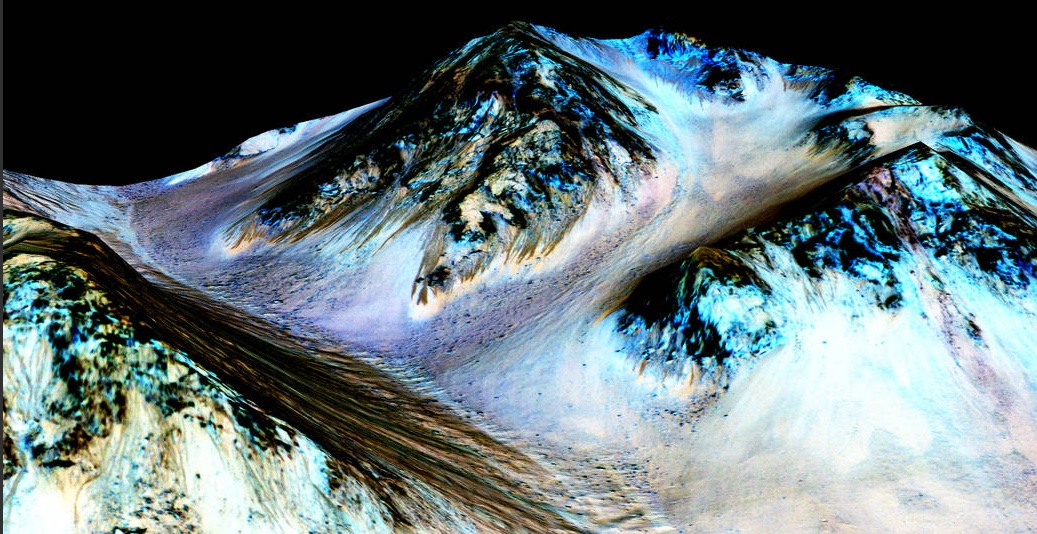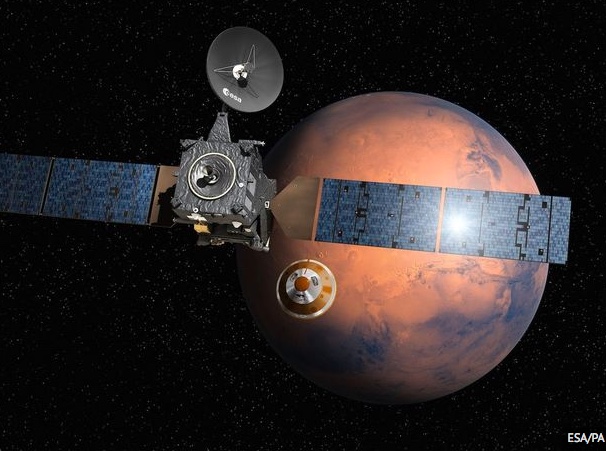Will we kill (or contaminate) microbial life on Mars?
October 20, 2016

These dark, narrow, 100 meter-long streaks called recurring slope lineae flowing downhill on Mars are inferred to have been formed by contemporary flowing water. Planetary scientists detected hydrated salts on these slopes at Hale crater, corroborating their original hypothesis that the streaks are indeed formed by liquid water. The blue color seen upslope of the dark streaks are thought not to be related to their formation, but instead are from the presence of the mineral pyroxene. (credits: NASA/JPL/University of Arizona)
Recent evidence of water, complex organic molecules, and methane in the Martian environment, combined with findings from the 1976 Viking mission, have led to the conclusion that existing microbial life on Mars is a possibility that must be considered, according to the authors of a paper in the journal Astrobiology (open-access until November 15, 2016).
Coauthors Gilbert V. Levin, Arizona State University, Tempe, and Patricia Ann Straat, National Institutes of Health, Bethesda, MD (retired), outline the evidence to support the “biological hypothesis,” which argues that the results of the 1976 Viking Labeled Release experiment were positive for extant microbial life on the surface of Mars.
The authors also evaluate the “non-biological hypotheses” to explain the Viking results, which many scientists support. But the authors conclude that the experimental evidence supports a biological explanation and the likelihood that microorganisms were able to evolve and adapt to be able to survive in the harsh conditions of the Martian environment.
“Even if one is not convinced that the Viking LR results give strong evidence for life on Mars, this paper clearly shows that the possibility must be considered,” says Chris McKay, PhD, Senior Editor of Astrobiology and an astrobiologist with NASA Ames Research Center.
“We cannot rule out the biological explanation,” McKay said. “This has implications for plans for sample return from Mars and for future human missions.”
Probing the Mars atmosphere for signs of life

Artist’s impression of ExoMars 2016 Trace Gas Orbiter (TGO)and separation of Schiaparelli, the entry, descent and landing demonstrator module. (credit: ESA)
ExoMars, a joint mission between the European Space Agency and Roscosmos, the Russian space agency, with the goal of exploring “whether life has ever existed on Mars,” entered Mars orbit Oct. 19. On Oct. 20, after separation, Schiaparelli, the entry, descent and landing demonstrator module, landed on Mars, but the signal was lost, according to ESA.
Loss of the Schiaparelli lander is a major disappointment. It was designed to test a new Entry Descent and Landing Module to be used by ExoMars 2020, which will be deployed in four years to land a rover designed to search for life below the planet’s surface at a depth of two meters. That’s below the zone in which UV radiation from the sun is able to destroy organic matter.
Meanwhile, with a science payload of four instruments, the Trace Gas Orbiter (TGO) will investigate trace gases — those gases that are present in small concentrations in the atmosphere — with particular focus on hydrocarbons and sulphur species, some of which could be signatures of active biological or geological processes, at present or in the past.
National Geographic Channel | MARS Trailer
The year is 2033, and humankind’s first Mars crew is about to launch. This is the story of how we make Mars home, told by the pioneers making it possible. MARS, a global miniseries event, premieres this November on National Geographic.
Abstract of The Case for Extant Life on Mars and Its Possible Detection by the Viking Labeled Release Experiment
The 1976 Viking Labeled Release (LR) experiment was positive for extant microbial life on the surface of Mars. Experiments on both Viking landers, 4000 miles apart, yielded similar, repeatable, positive responses. While the authors eventually concluded that the experiment detected martian life, this was and remains a highly controversial conclusion. Many believe that the martian environment is inimical to life and the LR responses were nonbiological, attributed to an as-yet-unidentified oxidant (or oxidants) in the martian soil. Unfortunately, no further metabolic experiments have been conducted on Mars. Instead, follow-on missions have sought to define the martian environment, mostly searching for signs of water. These missions have collected considerable data regarding Mars as a habitat, both past and present. The purpose of this article is to consider recent findings about martian water, methane, and organics that impact the case for extant life on Mars. Further, the biological explanation of the LR and recent nonbiological hypotheses are evaluated. It is concluded that extant life is a strong possibility, that abiotic interpretations of the LR data are not conclusive, and that, even setting our conclusion aside, biology should still be considered as an explanation for the LR experiment. Because of possible contamination of Mars by terrestrial microbes after Viking, we note that the LR data are the only data we will ever have on biologically pristine martian samples. Key Words: Extant life on Mars—Viking Labeled Release experiment—Astrobiology—Extraterrestrial life—Mars. Astrobiology 16, 798–810.